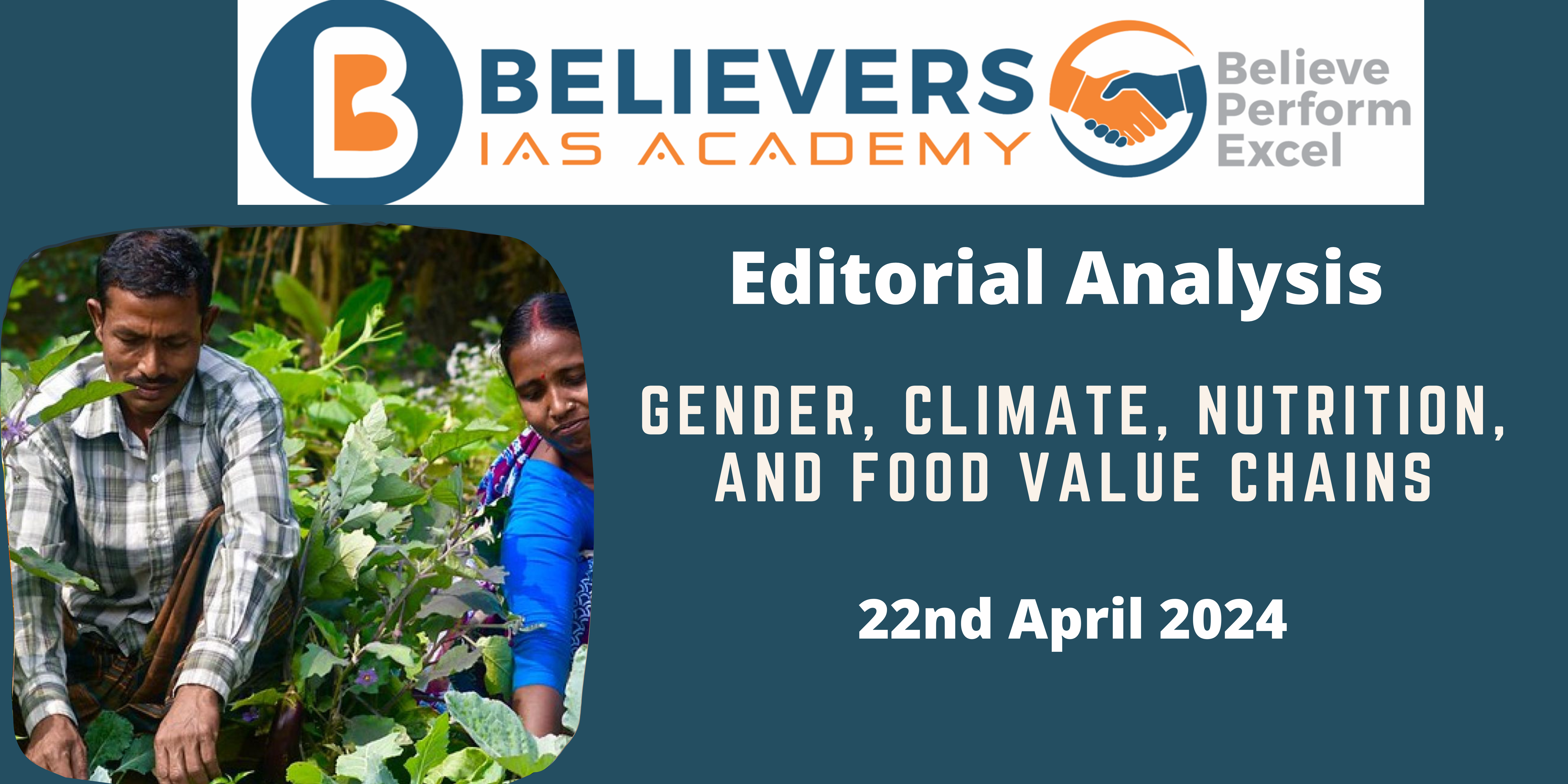Gender, Climate, Nutrition, and Food Value Chains
Context:
A group of women from a self-help group in Khamdorgi village of Chhattisgarh, has undertaken multi-layer farming on a small piece of land to combat land degradation, malnutrition, and ensure consistent income.
- This initiative, which involves growing various crops in layers, highlights the intricate relationship between climate change, nutrition, and food security, calling for comprehensive interventions at both global and regional levels.
Relevance:
GS-02 GS-03 (Conservation, Government policies and interventions)
Facts for Prelims:
- Food value chain: It is the process of the flow of goods that includes the movement and storage of raw materials, inventory and finished goods from point of origin to point of consumption.
Dimensions of the Article:
- What is the Issue
- How the Intersection of gender, climate, nutrition, and food value chains works
- Advantages
- Current Challenges
- Suggested Measures
What is the Issue:
- The intersection of gender, climate, nutrition, and food value chains presents a complex challenge that requires urgent attention.
- Climate change affects agricultural productivity, nutritional quality, and food accessibility, exacerbating existing challenges in food security and nutrition.
- Gender disparities further compound these issues, with women disproportionately affected by climate change and poor nutrition despite their crucial role in food systems.
How the Intersection of gender, climate, nutrition, and food value chains works :
- The climate impacts food value chains, altering agricultural yields and nutritional content.
- As a result, populations face difficulties in accessing diverse and nutrient-rich diets, contributing to widespread malnutrition.
- In India, malnutrition remains a significant concern, with a large proportion of the population unable to afford healthy diets.
- Roughly 14.37% of India’s population is not receiving enough nutrition.
- The 2023 Global Hunger Index (GHI) ranks India 111 out of 125 countries, indicating a “serious” level of hunger severity for the country.
- India’s GHI score is 28.7 on a 100-point scale, where 0 is the best score (no hunger) and 100 is the worst
- Moreover, unhealthy dietary patterns are driving an increase in non-communicable diseases, further underscoring the urgency of addressing this intersection.
Advantages:
- Despite these challenges, India has made progress in understanding the sustainability and nutritional aspects of diets.
- Indigenous food systems in Chhattisgarh, for instance, have sustained communities for generations by relying on locally available resources.
- By promoting indigenous foods and sustainable agricultural practices, communities can improve their nutrition status and resilience to climate change.
- Additionally, transitioning to plant-based diets can reduce environmental impact, as plant-based foods generally have lower carbon footprints compared to animal-based products.
Current Challenges:
- Gender disparities in access to resources, decision-making, and opportunities hinder women’s participation in sustainable agriculture and exacerbate their vulnerability to climate change and malnutrition.
- Moreover, existing food systems contribute to environmental degradation and greenhouse gas emissions, exacerbating the climate crisis.
- There is also a lack of comprehensive frameworks and tools to assess emissions linked to food production and consumption, hampering efforts to mitigate environmental impact.
Suggested Measures:
- Promoting Gender-Just Food Systems: Empowering women as equal stakeholders in food systems is essential for promoting resilience and sustainability. Gender-just food systems recognize women’s contributions and rights, leading to improved productivity, health, and nutritional outcomes.
- Scaling Up Sustainable Agriculture: Encouraging diversified food production systems and promoting indigenous crops can enhance food security and resilience to climate change. Initiatives like the Millet Mission Chhattisgarh demonstrate the potential of sustainable agriculture in addressing both nutritional and environmental concerns.
- Strengthening Monitoring and Assessment: Developing robust frameworks and tools to monitor emissions linked to food production and consumption is critical for mitigating environmental impact. Local communities should be involved in monitoring efforts to ensure inclusivity and accountability.
- Integrating Societal, Governmental, and Market Forces: Addressing the intersection of gender, climate, nutrition, and food value chains requires a multi-sectoral approach that integrates societal, governmental, and market forces. Policies should align with cultural values, societal norms, and market dynamics to promote sustainable and equitable food systems. Collaboration between stakeholders is essential for driving systemic change and achieving long-term sustainability goals.




